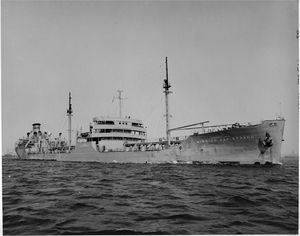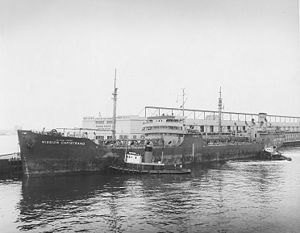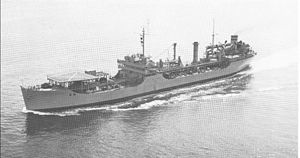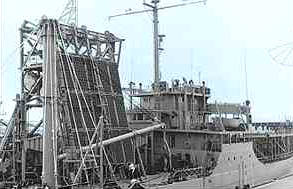USNS Mission Capistrano (T-AO-112): Difference between revisions
imported>Robert A. Estremo mNo edit summary |
Pat Palmer (talk | contribs) m (Text replacement - "[[U.S. Navy|" to "[[United States Navy|") |
||
| (27 intermediate revisions by 3 users not shown) | |||
| Line 1: | Line 1: | ||
{{subpages}} | |||
{| border="1" align="right" cellpadding="2" cellspacing="0" width="300" style="margin: 0 0 1em 0.5em" | {| border="1" align="right" cellpadding="2" cellspacing="0" width="300" style="margin: 0 0 1em 0.5em" | ||
|align="center" colspan="2"|[[Image: | |align="center" colspan="2"|[[Image:091911204.jpg|300px]] <small>USNS ''Mission Capistrano'' (T-AO-112) underway off the Port of Long Beach, date unknown.<ref>{{091911204.jpg/credit}}</ref></small><br/> | ||
|- | |- | ||
!colspan="2" style="color: white; height: 30px; background: navy;"| History | !colspan="2" style="color: white; height: 30px; background: navy;"| History | ||
|- | |- | ||
| [[Ship ceremonies|Laid down]]: | |[[Ship ceremonies|Laid down]]: | ||
| 29 February 1944 | |29 February 1944 | ||
|- | |- | ||
| [[Ship ceremonies|Launched]]: | |[[Ship ceremonies|Launched]]: | ||
| 7 May 1944 | |7 May 1944 | ||
|- | |- | ||
| Delivered: | |Delivered: | ||
| 14 June 1944 | |14 June 1944 | ||
|- | |- | ||
| [[Naval Vessel Register|Struck]]: | |[[Naval Vessel Register|Struck]]: | ||
| 1 January 1955 | |1 January 1955 | ||
|- | |- | ||
|Fate: | |Fate: | ||
| | |Scrapped | ||
|- | |- | ||
!colspan="2" style="color: white; height: 30px; background: navy;"| General Characteristics | !colspan="2" style="color: white; height: 30px; background: navy;"| General Characteristics | ||
|- | |- | ||
|Hull type: | |Hull type: | ||
| T2-SE-A2 | |T2-SE-A2 | ||
|- | |- | ||
|Displacement: | |Displacement: | ||
| 5,532 | |5,532 tn light;<br>21,880 tn full | ||
|- | |- | ||
|Length: | |Length: | ||
| 524 ft (160 m) | |524 ft (160 m) | ||
|- | |- | ||
|Beam: | |Beam: | ||
| 68 ft (21 m) | |68 ft (21 m) | ||
|- | |- | ||
|Draft: | |Draft: | ||
| 30 ft (9.0 m) | |30 ft (9.0 m) | ||
|- | |- | ||
|Speed: | |Speed: | ||
| 16.5 [[knot (speed)| | |16.5 [[knot (speed)|kt]] (31 km/h) | ||
|- | |- | ||
|Complement: | |Complement: | ||
| 52 | |52 | ||
|- | |||
|Propulsion: | |||
||Turbo-electric, single screw, 6,000 hp | |||
|- | |- | ||
|Armament (WWII): | |Armament (WWII): | ||
| 2 x 5 in (2x1)<br>8 x 20mm (8x1) | |2 x 5 in (2x1)<br>8 x 20mm (8x1) | ||
|} | |} | ||
'''USNS ''Mission Capistrano'' (AO-112)''' | '''USNS ''Mission Capistrano'' (T-AO-112)''' was the second of twenty-seven ''[[Mission Buenaventura-class oiler|Mission Buenaventura]]''-class tankers built during [[World War II]] for service as fleet oilers in the [[United States Navy]]. Named for California's [[Mission San Juan Capistrano]], she was the first of only two [[United States Navy|U.S. Naval]] vessels to date to have borne the name. | ||
==Operational history== | ==Operational history== | ||
| Line 53: | Line 58: | ||
Redesignated '''USNS ''Mission Capistrano'' (T‑AO‑112)''', she was transferred to the operational control of MSTS on the same date. She continued her service with MSTS until 1 January 1955 when she was placed out of service, struck from the Naval Vessel Register, and transferred to the Maritime Administration and laid up at the Beaumont, Texas Reserve Fleet. Reacquired by the Navy on 5 July 1956, she was transferred to MSTS on the same date and placed in service for further duty with MSTS. She continued her voyages along the world’s tanker routes transporting oil to and from the United States until early 1960, when she entered the Todd Pacific Shipyards at New Orleans, Louisiana for conversion to a "Sound Testing Ship." Reclassified '''USNS ''Mission Capistrano'' (AG‑162)''' on 1 July 1960 she was modified to carry an ultra‑high‑powered sonar transducer array some five stories high and several tons in weight. The transducer could be raised and lowered like a centerboard through the ship’s bottom. Upon completion of her conversion, she was placed in service as '''USNS ''Mission Capistrano'' (T-AG-162)''' (date unknown) and joined "Project ARTEMIS," a project intended to ultimately produce a system that could detect submarines at long range. | Redesignated '''USNS ''Mission Capistrano'' (T‑AO‑112)''', she was transferred to the operational control of MSTS on the same date. She continued her service with MSTS until 1 January 1955 when she was placed out of service, struck from the Naval Vessel Register, and transferred to the Maritime Administration and laid up at the Beaumont, Texas Reserve Fleet. Reacquired by the Navy on 5 July 1956, she was transferred to MSTS on the same date and placed in service for further duty with MSTS. She continued her voyages along the world’s tanker routes transporting oil to and from the United States until early 1960, when she entered the Todd Pacific Shipyards at New Orleans, Louisiana for conversion to a "Sound Testing Ship." Reclassified '''USNS ''Mission Capistrano'' (AG‑162)''' on 1 July 1960 she was modified to carry an ultra‑high‑powered sonar transducer array some five stories high and several tons in weight. The transducer could be raised and lowered like a centerboard through the ship’s bottom. Upon completion of her conversion, she was placed in service as '''USNS ''Mission Capistrano'' (T-AG-162)''' (date unknown) and joined "Project ARTEMIS," a project intended to ultimately produce a system that could detect submarines at long range. | ||
Decommissioned in 1970 and transferred to the Maritime Administration for lay up in the "National Defense Reserve Fleet," ''Mission Capistrano'' was sold by the Maritime Administration (MARAD) for commercial purposes on July 10, 1972 to the Boston Metals Company. The vessel was subsequently acquired by the Mission Drilling and Exploration Corporation on March 15, 1973 for conversion to a drilling ship. In 1975 the name was changed to '''SS ''Mission Exploration'''''; she was subsequently scrapped at Brownsville, Texas in June of 1980. | |||
==Gallery== | |||
<gallery perrow=3 widths=300px heights=250px> | |||
Image:USNS Mission Capistrano (T-AO-112) moored pierside, Port of Los Angeles, Berth 232, date unknown.jpg|{{USNS Mission Capistrano (T-AO-112) moored pierside, Port of Los Angeles, Berth 232, date unknown.jpg/credit}}USNS ''Mission Capistrano'' (T-AO-112) moored pierside, Port of Los Angeles, Berth 232, date unknown. | |||
Image:USNS Mission Capistrano.jpg|{{USNS Mission Capistrano.jpg/credit}}USNS ''Mission Capistrano'' (T-AG-162) at sea, date and location unknown. A helicopter landing pad has been added just aft of the [[forecastle]] as part of her conversion. | |||
Image:Mission Capistrano T-AG-162.jpg|{{Mission Capistrano T-AG-162.jpg/credit}}A view of USNS ''Mission Capistrano'' (T-AG-162)'s ultra-high-powered sonar transducer array. The five-story-high, 30-ton assembly was (at the time) the world's largest sonar source. | |||
</gallery> | |||
==Notes== | |||
{{reflist}} | |||
==References== | ==References== | ||
* [http://www.history.navy.mil/danfs/m11/mission_capistrano.htm Dictionary of American Naval Fighting Ships] (Primary source for this article) | * [http://www.history.navy.mil/danfs/m11/mission_capistrano.htm Dictionary of American Naval Fighting Ships] (Primary source for this article) | ||
* {{cite web|title=AO-112 / T-AO-112 / T-AG-162 ''Mission Capistrano''|work=Fleet Oiler (AO) Photo Index|url=http://www.navsource.org/archives/09/19/19112.htm|accessdate=July 11|accessyear=2007}} | * {{cite web|title=AO-112 / T-AO-112 / T-AG-162 ''Mission Capistrano''|work=Fleet Oiler (AO) Photo Index|url=http://www.navsource.org/archives/09/19/19112.htm|accessdate=July 11|accessyear=2007}} | ||
* {{cite web|title=''Mission Capistrano'' / ''Mission Capistrano'' AO-112|work=Maritime Quest|url=http://www.maritimequest.com/warship_directory/us_navy_pages/auxiliary/oilers/mission_capistrano_ao_112_page_1.htm|accessdate=December 4|accessyear=2008}} | |||
[[Category:CZ Live]] | [[Category:CZ Live]] | ||
[[Category:Military Workgroup]] | [[Category:Military Workgroup]] | ||
Latest revision as of 10:40, 10 February 2023
 USNS Mission Capistrano (T-AO-112) underway off the Port of Long Beach, date unknown.[1] USNS Mission Capistrano (T-AO-112) underway off the Port of Long Beach, date unknown.[1] | |
| History | |
|---|---|
| Laid down: | 29 February 1944 |
| Launched: | 7 May 1944 |
| Delivered: | 14 June 1944 |
| Struck: | 1 January 1955 |
| Fate: | Scrapped |
| General Characteristics | |
| Hull type: | T2-SE-A2 |
| Displacement: | 5,532 tn light; 21,880 tn full |
| Length: | 524 ft (160 m) |
| Beam: | 68 ft (21 m) |
| Draft: | 30 ft (9.0 m) |
| Speed: | 16.5 kt (31 km/h) |
| Complement: | 52 |
| Propulsion: | Turbo-electric, single screw, 6,000 hp |
| Armament (WWII): | 2 x 5 in (2x1) 8 x 20mm (8x1) |
USNS Mission Capistrano (T-AO-112) was the second of twenty-seven Mission Buenaventura-class tankers built during World War II for service as fleet oilers in the United States Navy. Named for California's Mission San Juan Capistrano, she was the first of only two U.S. Naval vessels to date to have borne the name.
Operational history
Originally laid down on 29 February 1944 as a Maritime Commission type (T2-SE-A2) tanker hull (MC hull 1819) under a Maritime Commission contract as SS Mission Capistrano at the Marine Ship Corporation in Sausalito, California; launched on 7 May 1944; sponsored by Mrs. James E. George; and delivered on 14 June 1944. Chartered to Pacific Tankers Inc., she spent the rest of the War supporting allied forces overseas (during which time she was awarded the National Defense Service Medal), until returned to the Maritime Commission on 20 April 1946 and laid up at the Maritime Commission Reserve Fleet at Mobile, Alabama. Acquired by the Navy on 17 November 1947, she was designated as Mission Capistrano (AO‑112) and transferred to the Naval Transportation Service for duty. She served with this service until 1 October 1949 when the Naval Transportation Service was absorbed into the new Military Sea Transportation Service (MSTS).
Redesignated USNS Mission Capistrano (T‑AO‑112), she was transferred to the operational control of MSTS on the same date. She continued her service with MSTS until 1 January 1955 when she was placed out of service, struck from the Naval Vessel Register, and transferred to the Maritime Administration and laid up at the Beaumont, Texas Reserve Fleet. Reacquired by the Navy on 5 July 1956, she was transferred to MSTS on the same date and placed in service for further duty with MSTS. She continued her voyages along the world’s tanker routes transporting oil to and from the United States until early 1960, when she entered the Todd Pacific Shipyards at New Orleans, Louisiana for conversion to a "Sound Testing Ship." Reclassified USNS Mission Capistrano (AG‑162) on 1 July 1960 she was modified to carry an ultra‑high‑powered sonar transducer array some five stories high and several tons in weight. The transducer could be raised and lowered like a centerboard through the ship’s bottom. Upon completion of her conversion, she was placed in service as USNS Mission Capistrano (T-AG-162) (date unknown) and joined "Project ARTEMIS," a project intended to ultimately produce a system that could detect submarines at long range.
Decommissioned in 1970 and transferred to the Maritime Administration for lay up in the "National Defense Reserve Fleet," Mission Capistrano was sold by the Maritime Administration (MARAD) for commercial purposes on July 10, 1972 to the Boston Metals Company. The vessel was subsequently acquired by the Mission Drilling and Exploration Corporation on March 15, 1973 for conversion to a drilling ship. In 1975 the name was changed to SS Mission Exploration; she was subsequently scrapped at Brownsville, Texas in June of 1980.
Gallery
(PD) Photo: Joe Radigan MACM / United States Navy
USNS Mission Capistrano (T-AG-162) at sea, date and location unknown. A helicopter landing pad has been added just aft of the forecastle as part of her conversion.
Notes
- ↑ (PD) Photo: United States Navy / David Buell
References
- Dictionary of American Naval Fighting Ships (Primary source for this article)
- AO-112 / T-AO-112 / T-AG-162 Mission Capistrano. Fleet Oiler (AO) Photo Index. Retrieved on July 11, 2007.
- Mission Capistrano / Mission Capistrano AO-112. Maritime Quest. Retrieved on December 4, 2008.


